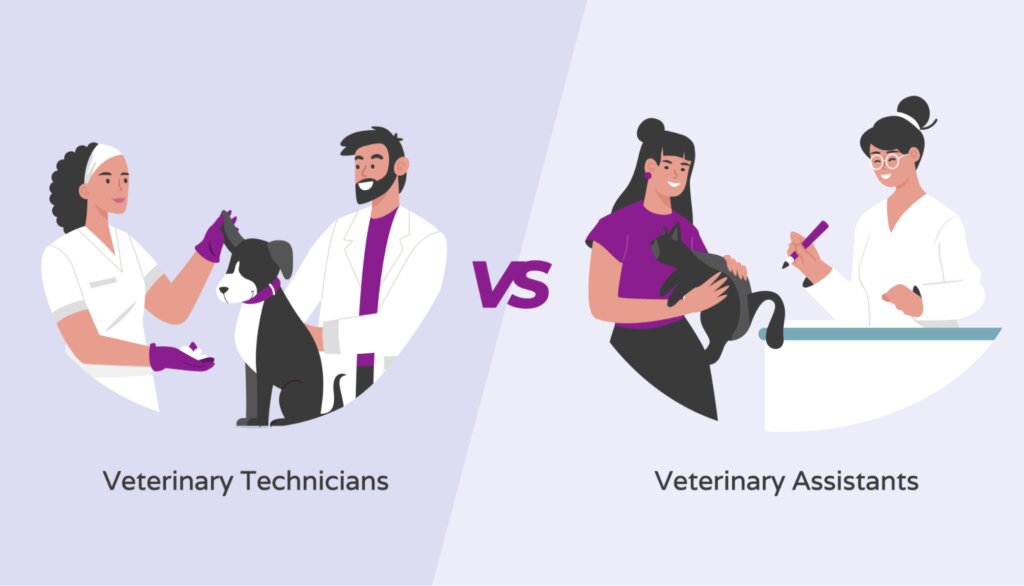Career Tips
Difference Between A Vet Tech vs. Vet Assistant

Those searching for a shorter career path that involves working with animals might consider becoming a vet tech or vet assistant. Both roles contribute to veterinarian clinic activities and animal interactions. Learning about how different positions compare will help you decide which one is best for you. In this post, we’ll look at what a vet tech performs, what a vet assistant is, and the differences between the two.
What are vet techs and vet assistants?
Vet techs and vet assistants collaborate with one another and with veterinarians in animal clinics and hospitals. A vet tech, or veterinary technician, is an animal nurse who works alongside veterinarians to help animals live healthy lives. Their responsibilities include diagnosing and treating animals in animal hospitals, private clinics, and research centers. Some work responsibilities may include monitoring vital signs, prepping animals for surgery, and taking X-rays. Veterinary technicians use clinical knowledge to provide routine and emergency treatment to animals.
In contrast, a vet assistant is a professional who assists with daily activities while working under the supervision of a veterinarian or veterinary technician. While vet assistants do not do technical jobs, they do aid feed, bathe, and exercise the animals in their facility’s care. They may also do laboratory tasks, such as collecting urine samples or extracting blood.
Vet tech vs. vet assistant
The following are some ways a vet tech position compares to a vet assistant position:
Job duties
Vet techs and vet assistants collaborate with one another and with veterinarians in animal clinics and hospitals. A vet tech, or veterinary technician, is an animal nurse who works alongside veterinarians to help animals live healthy lives. Their responsibilities include diagnosing and treating animals in animal hospitals, private clinics, and research centers.
Some work responsibilities may include monitoring vital signs, prepping animals for surgery, and taking X-rays. Veterinary technicians use clinical knowledge to provide routine and emergency treatment to animals.
In contrast, a vet assistant is a professional who assists with daily activities while working under the supervision of a veterinarian or veterinary technician. While vet assistants do not do technical jobs, they do aid feed, bathe, and exercise the animals in their facility’s care. They may also do laboratory tasks, such as collecting urine samples or extracting blood.
Education
A vet tech requires more education than a vet assistant. These professionals pursue an associate degree in veterinary technology over the course of two years to gain the necessary skills and knowledge for their positions. Courses include animal behavior, clinical procedures, biochemistry, and animal pharmacology.
During their education, vet techs complete a set amount of observational hours to better grasp their function. Vet technologists can also seek a bachelor of science in veterinary technology to advance their careers and potentially earn more money. Vet technologists can further their education in a variety of disciplines, including equine internal medicine.
A high school diploma or GED is the minimal educational requirement for a veterinarian assistant. However, certain organizations may prefer candidates with an associate’s degree or certification. Common associate degrees for vet assistants include a degree in veterinary technology, which can help them develop in their careers in the future. In high school, focusing on biology studies may help vet assistants prepare for a career working with animals.
Training
A vet tech spends a set amount of hours at an animal hospital while attending school to learn how to perform various responsibilities. This gives them practical experience in dealing with various circumstances. They also begin to gain the abilities required to do their profession.
Because vet assistants are not required to complete extra school, they get much of their knowledge while working at an animal hospital or private clinic. Many businesses provide on-the-job training for vet assistants, but they may prefer candidates with prior experience working with animals. They may also get relevant skills by completing a certification program.
Licensing
Both veterinary technicians and veterinary assistants can obtain career-related credentials. Vet techs who have completed their degree are eligible to take the Veterinary Technician National Exam (VTNE) or a state-level board exam. Passing these tests qualifies them to become a registered or certified veterinary technician. They also obtain a veterinary technician license in the state where they intend to practice and complete continuing education units to renew it on a regular basis.
Some veterinary assistants seek to become certified through one of the National Association of Veterinary Technicians in America (NAVTA) veterinary assistant programs in order to advance their careers. These take between six months and a year to finish. Individuals who complete these programs can become accredited veterinary assistants (AVAs). There are no licensing requirements to become a veterinarian assistant.
Career path
Because vet techs and vet assistants are at different phases of their careers, they can pursue a variety of pathways. Someone who has worked as a vet tech for a while can advance to the position of veterinarian. This involves obtaining a four-year Doctor of Veterinary Medicine (DVM) degree.
A vet assistant can become a vet tech by obtaining an associate degree in veterinary technology. Their job can help students prepare for a career as a veterinary technician. Similarly, vet assistants can start their road to become veterinarians.
Specializations
Another difference between the two roles is the type of job duties they perform. Vet techs tend to perform more specialized tasks and have the opportunity to pursue a specialization. Some specialty areas they can choose from include:
- Zoological medicine
- Internal medicine
- Emergency care
- Dental technology
- Anesthesia
Vet assistants typically conduct a greater range of employment activities. In addition to assisting the veterinarian team with animal care, they may also serve customers and conduct secretarial tasks. Unlike vet technologists, vet assistants have no areas of specialization to study.
Hours
Typically, veterinarian technicians work full-time. Depending on where they work, they may have to work weekends, holidays, or at night. Vet technicians may often work extended hours to care for animals recovering from surgery.
Vet assistants frequently work part-time and have flexible work schedules. Workers in 24-hour facilities may work irregular hours to care for animals on weekends and holidays. A veterinarian assistant’s shifts are usually eight hours long.
Salary and job outlook
Another distinction between a vet tech and a vet assistant is how much money they earn. Vet technologists typically earn significantly more than vet assistants because they complete additional coursework and perform more technical jobs. According to the United States Bureau of Labor Statistics (BLS), the pay for the two roles are as follows:
- Vet tech: $36,260 per year
- Vet assistance: $29,930 per year
The BLS predicts that employment for vet techs and vet assistants will increase by 16% between 2019 and 2029. This is four times the average growth rate of other occupations. The BLS attributes this increase to the growing need for veterinarians operating on animals and vet techs to do general care chores as more people own pets. Employment in these fields may increase as the demand for veterinary procedures rises.












